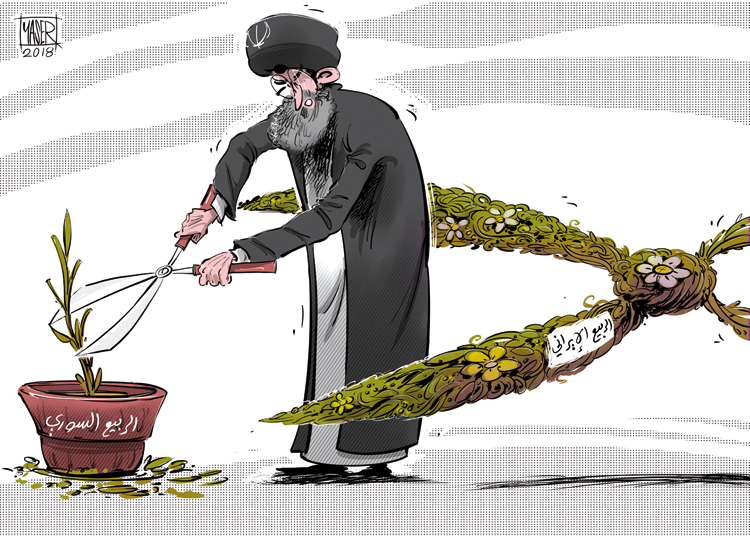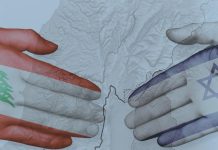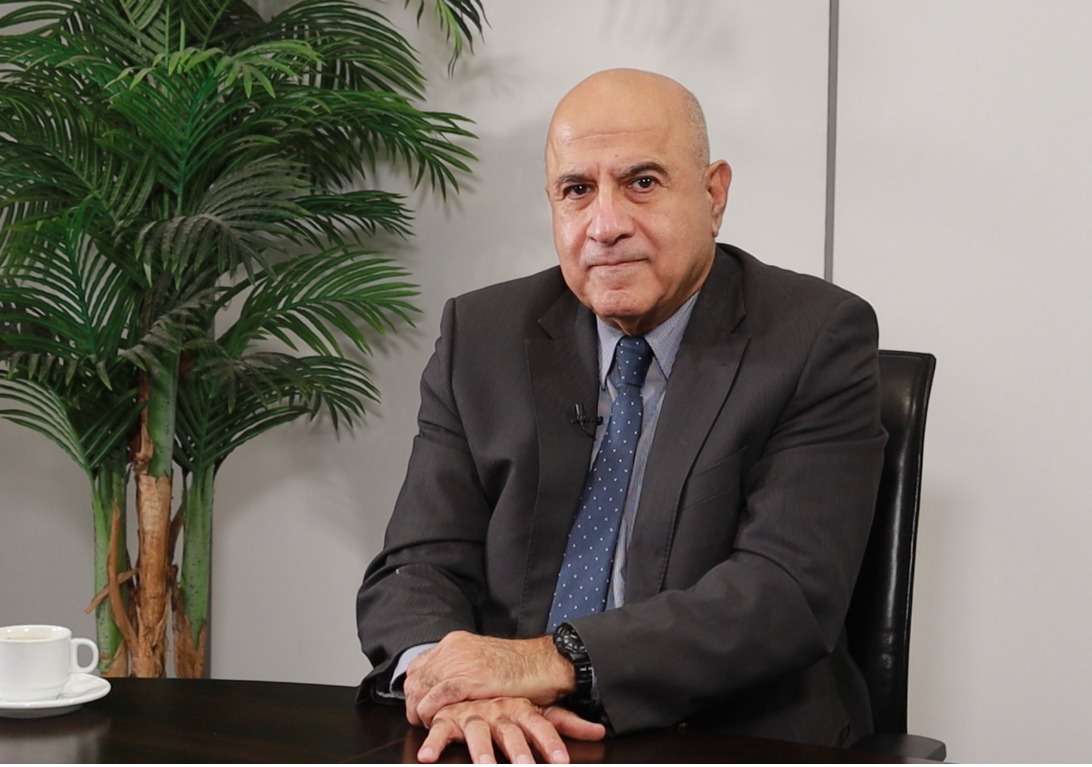Iran’s costly Syria war mainly behind its manifold crises
Huda al-Husseini/Al Arabiya/January 19/18
Many have congratulated Iran that its recent crisis has come to an end and some even traveled to Tehran to congratulate officials face to face. However, the crisis has not ended and it’s actually very complicated.
According to some media reports, increased prices of poultry and poultry products sparked the protests. The Iranian authorities claim that egg prices increased by 40% due to bird flu. Egg prices increased by 30% in last November while the price of the Iranian rial in the black market decreased to 42,000 rials per one dollar from 39,000 rial. This led to significant increase in the overall inflation rate – – but not overly high – which is now 11%. The increase in egg prices is inconvenient but it does not make hundreds of thousands of people take to the streets. Before the authorities blocked social media networks, Radio Farda published on January 2 a video that shows protestors burning a police station in Qahderijan which is 24 kilometers away from Isfahan. Qahderijan is very small and no one thinks about it. Its villagers have felt injustice as the river of Zayanderud which irrigates Isfahan dries before it reaches their village. This is due to Iran’s mismanagement of dwindling water resources.
No water
Qahderijan protests began a while ago. Two years ago, Isa Kalantari, the Iranian environment ministry’s advisor, warned that 50 million Iranians will have no water because 70% of underground water has been exhausted and river streams have been misused to compensate for decreased amounts of water. A source told me that agriculture in Iran consumes 92% of water. Not maintaining sources of water pushed farmers to go to cities which already suffer from 30% of unemployment. Former President Mahmoud Ahmedinejad realized that climate change and mismanagement of water resources are destroying farms so he provided financial aid to families who are trying hard to provide food for their children. When current President Hassan Rouhani hinted that he will decrease these benefits, protests erupted.
Although unrest in the past few weeks were due to increased egg prices and decreasing aid, one of the major economic challenges is actually due to the severe drought which began in the late 1990’s.
Iran is subject to climate change and that the entire Gulf region will witness higher temperatures by 2070. This is according to a study published in 2015 by MIT. Last summer, Iran recorded one of the highest temperatures on earth, 53.72 degrees Celsius. In the past years, the Iranian government acknowledged that climate change poses a serious threat.
Imminent economic crisis
Last year, a number of observers warned of an imminent economic crisis. Meanwhile, the Iranian military expenditure estimates in Syria range between $6 billion to $15 and $20 billion a year. This includes $4 billion of direct expenses in addition to supporting Hezbollah in Lebanon and other armed groups which Iran established. “Let’s assume that the lesser estimates are closer to the real numbers. The cost of the Syrian war on the Iranian regime is almost equal to the total deficit in the country’s budget which reaches $9.3 billion a year,” a source said.
Iran suffers from several crises. Managing water is only one thing of many other issues which have accumulated since the 1979 revolution. He added that the Iranian regime is willing to sacrifice what the economy desperately needs in favor of its ambitions in Syria. According to the Central Bank, Iran decreased expenditure on development to one-third while the state’s revenues fell short of expectations during the last three quarters which ended in December.
Iran suffers from several crises. Managing water is only one thing of many other issues which have accumulated since the 1979 revolution. For example, pension funds face bankruptcy in the short term. There are also the government’s annual arrears to the social security which suffers from lack of funds. Given the number of Iranians who reached old age, we can tell that Iran is a country that’s getting older before it gets rich, and this will affect pension payments resulting in a crisis that will be much worse than any other crisis.
Pressure on banks
Iran’s banking system, the source said is facing difficulties due to economic pressures and due to internal funds granted to investors who are affiliated with the regime. “The cost of the financial saving plan may reach 50% of the local GDP,” he said. He said that according to a report by Donia Economy daily, the non-productive assets in banks represent 40% to 50% of total bank assets in the country. This is according to official data. Around 15% of these assets are immovable assets like land and buildings, while the rest are debt. There are no official data on the bank’s fixed assets.
According to another daily, the total value of immovable property owned by 31 banks and financial institutions was estimated at $13.8 billion. There are many banks in Iran which provide an interest as high as 30% on deposits. In 2017, the regime decided that the interest must be 15% but few adhered to the decision. The government responded by letting private credit institutions collapse. Deposits worth tens of millions for small depositors thus evaporated, while many unauthorized lending companies, which spread during Ahmedinejad’s term and provided loans when construction boomed, collapsed.
A financial source said reorganizing the Iranian banking system which is worth $700 billion will cost between $180 and $200 billion, i.e. 50% of Iran’s GDP. Iran cannot bear this as its GDP is $428 billion.
Youth unemployment high
Iran has many talented people who are not employed. Unemployment among youth is around 20%. This is in addition to the unemployment which 4.7 million students suffer from. Iran has plenty of higher engineering schools but the majority of graduates look forward to immigrate. According to Tehran’s chamber of commerce, there are 3.5 million Iranians preparing to leave the country. If we add the cost of returning banks’ capitals and the cost of saving pension funds and fixing the water resources, the total will exceed the GDP. Although the government’s direct debt is little, the Iranian regime is drowning in unfunded liabilities.
It’s not clear how the current Iranian regime or any future regime will resolve these intertwining crises. Iran needs a tough program to fight corruption like the one which Chinese President Xi Jinping submitted, the source suggested. Iran cannot continue pursuing these foreign military adventures and its ambitious ballistic missiles’ program.
Regime unable to cope
The current regime is not capable of carrying out this costly and complicated transformation and it does not even have a clear vision on how to begin handling these problems which have been accumulating for 39 years. Protests confirmed that the regime has lost its credibility and this will make it harder for the regime to maneuver.
My source added: “To confront such problems, third world countries usually decrease their commitments by decreasing the value of the currency and inflation. Pensions and liabilities are the people’s right but the government makes money in hard currency, and decreasing the value of the currency and inflation means transferring the fortune from people to the regime,” the source said.
“The expected result is a long phase of instability which includes sporadic violent protests and further economic deterioration.”
تكلفة الحرب في سوريا وراء أزمات إيران!
هدى الحسيني/الشرق الأوسط/18 كانون الثاني/18
تكاثر مهنئو إيران بانتهاء الأزمة الأخيرة، ومنهم من سافر إلى طهران ليقدم التهاني وجهاً لوجه، لكن الأزمة لم تنتهِ وهي جد معقدة، وفقاً لتقارير إعلامية أثارت قفزة في أسعار الدواجن ومشتقاتها المظاهرات. وتدعي السلطات الإيرانية أن ارتفاع أسعار البيض بنسبة 40 في المائة كان بسبب تفشي إنفلونزا الطيور، على الرغم من أن سعر البيض ارتفع بنسبة 30 في المائة اعتباراً من شهر نوفمبر (تشرين الثاني) الماضي، كما انخفض سعر الريال الإيراني في السوق السوداء إلى 42 ألف ريال لكل دولار، من 39 ألفاً، مما أدى إلى ارتفاع كبير إنما غير مبالغ فيه بالنسبة إلى معدل التضخم الإجمالي الذي يبلغ الآن حوالي 11 في المائة.
ارتفاع سعر البيض مزعج، لكنه وحده لا يسبب خروج مئات الآلاف من كل المناطق إلى الشوارع، وكانت إذاعة «فاردا»، قبل أن تغلق السلطات وسائل التواصل الاجتماعي نشرت في الثاني من الشهر الحالي فيديو يظهر فيه المتظاهرون وهم يحرقون مركزاً للشرطة في مدينة غاهداريجان التي تبعد 24 كلم عن مدينة أصفهان، وغاهداريجان صغيرة ولا أحد يفكر فيها، لكن القرويين شعروا بالظلم، فنهر زاياناده رد (معطي الحياة)، الذي يروي أصفهان، يجف قبل وصوله إلى قريتهم، وهذا ضحية سوء إدارة إيران للموارد المائية المتضائلة.
احتجاجات غاهداريجان بدأت منذ زمن. وقبل عامين حذر عيسى كالنداري مستشار وزارة البيئة الإيرانية من أن 50 مليون إيراني سيُتركون من دون مياه بسبب استنفاد 70 في المائة من المياه الجوفية وإساءة تغيير مجرى الأنهار للتعويض.
يقول محدثي، إن الزراعة في إيران تستهلك 92 في المائة من المياه، وعدم المحافظة على المياه دفع فلاحي تلك الأراضي إلى المدن التي تعاني بالفعل من حوالي 30 في المائة من بطالة الشباب. وكان الرئيس السابق محمود أحمدي نجاد أدرك أن تغيير المناخ وسوء إدارة المياه يدمران مزارع الأسر، فقدم إعانات مادية للأسر التي تكافح من أجل توفير الطعام لأولادها، وعندما لمح الرئيس الحالي حسن روحاني إلى أنه سيقلل من هذه الفوائد، ثارت الاحتجاجات. وفي حين أن الاضطرابات في الأسابيع الأخيرة كانت بسبب ارتفاع أسعار البيض والتخفيضات للإعانات، إلا أن من أكبر التحديات الاقتصادية في إيران سببها موجة الجفاف الشديدة التي بدأت أواخر التسعينات، ويقول محدثي إن إيران معرضة بشكل متزايد للتغيير المناخي، وأن منطقة الخليج وبحلول عام 2070 يمكن أن تشهد ارتفاعاً كبيراً في موجات الحرارة، هذا وفقاً لدراسة معهد «ماساتشوستس للتكنولوجيا» نشرها عام 2015. ثم إنه في الصيف الفائت سجلت إيران واحدة من أعلى درجات الحرارة على الأرض (53,72 درجة مئوية).
في السنوات الأخيرة أقرت الحكومة الإيرانية بأن تغيير المناخ يشكل تهديداً حاداً. وخلال العام الماضي حذر عدد من المراقبين من حدوث أزمة اقتصادية وشيكة. ومن جهة أخرى، تتراوح تقديرات الإنفاق العسكري الإيراني في سوريا من 6 مليارات دولار إلى 15 أو 20 مليار دولار سنوياً، ويشمل ذلك 4 مليارات دولار من التكاليف المباشرة، فضلاً عن الدعم المقدم لـ«حزب الله» في لبنان وغيره من المجموعات المسلحة التي أنشأتها إيران وتسيطر عليها. يقول محدثي: لنفترض أن التقديرات الأقل هي الأقرب إلى الحقيقة، فيتبين أن تكلفة الحرب السورية على النظام الإيراني تساوي تقريباً العجز الكلي في ميزانية البلاد الذي يصل سنوياً إلى 9,3 مليار دولار. ويضيف أن النظام الإيراني على استعداد للتضحية بالاحتياجات الأكثر إلحاحاً للاقتصاد الداخلي لصالح طموحاته في سوريا. وحسب البنك المركزي فإن إيران خفضت الإنفاق على التنمية إلى الثلث، مع تراجع إيرادات الدولة عن التوقعات خلال الفصول الثلاثة المنتهية في ديسمبر (كانون الأول) الماضي.
تعاني إيران من أزمات متعددة وشعور عميق بالضيق. إدارة المياه ليست سوى واحد من الكثير من العجز المخفي الذي تراكم على إيران منذ الثورة عام 1979؛ إذ تواجه أجزاء كبيرة من نظام المعاشات للمتقاعدين الإفلاس على المدى القصير. والمتأخرات السنوية للحكومة إلى نظام الضمان الاجتماعي الذي يعاني من النقص في التمويل، هي عدة مرات حجم عجز ميزانيتها الرسمية، ومع نسبة الإيرانيين الذين وصلوا إلى سن الشيخوخة، فإن التركيبة السكانية ستجعل المشكلة الحرجة أسوأ بكثير خلال السنوات القليلة المقبلة. ويقول محدثي إن إيران هي أول دولة تشيخ قبل أن تصبح غنية، مما يؤدي إلى أزمة في معاشات التقاعد، أكثر حدة من أي أزمة أخرى في العالم.
ويصل محدثي إلى النظام المصرفي الإيراني المعسر، ويرجع السبب جزئياً إلى الضغوط الاقتصادية، وجزئياً إلى إقراض داخلي ضخم للمستثمرين العقاريين المتصلين بالنظام. ويقول: قد تصل تكلفة خطة الإنقاذ المالي إلى 50 في المائة من الناتج الإجمالي المحلي. وينقل عن صحيفة «دنيا الاقتصاد»، أن الأصول غير المنتجة في المصارف تمثل 40 إلى 50 في المائة من إجمالي الأصول المصرفية في البلاد «وفقاً للبيانات الرسمية». ويتكون ما يقرب من 15 في المائة من هذه الموجودات من أصول غير منقولة مثل الأراضي والمباني، والباقي من القروض المتعثرة والديون الحكومية، «ولا توجد بيانات رسمية عن الأصول الثابتة للبنوك». وحسب موقع «سيرات نيوز» الإلكتروني فقد قدر إجمالي قيمة الممتلكات غير المنقولة والمملوكة من 31 مصرفاً ومؤسسة مالية بقيمة 13,8 مليار دولار.
هناك الكثير من المصارف في إيران التي تقدم فائدة على الودائع تصل إلى 30 في المائة، وفي أوائل عام 2017 قرر النظام أن يكون سعر الفائدة 15 في المائة، لكن القليل امتثل، فردت الحكومة بالسماح بانهيار مؤسسات ائتمان خاصة، مما أدى إلى تبخر ودائع عشرات الملايين من المودعين الصغار، كما انهارت العديد من شركات الإقراض غير المصرح بها، وكانت انتشرت زمن أحمدي نجاد لتقدم قروضاً خلال طفرة البناء.
مصدر مالي قال إن إعادة التنظيم المالي للقطاع المصرفي الإيراني البالغ 700 مليار دولار، ستكلف ما بين 180 و200 مليار دولار، أي 50 في المائة من الناتج الإجمالي المحلي لإيران. وهذا لا تستطيع إيران تحمله، حيث إن الناتج الإجمالي المحلي لديها يصل إلى 428 مليار دولار.
لدى إيران الكثير من الموهوبين الذين لا يمكن توظيفهم، وتبلغ نسبة البطالة بين الشباب 20 في المائة مع استثناء البطالة التي يعاني منها 4.7 مليون طالب جامعي. ولدى إيران العديد من المدارس الهندسية العليا، لكن الغالبية العظمى من الخريجين يتطلعون إلى الهجرة، وحسب غرفة تجارة طهران فإن هناك 3.5 مليون إيراني يستعدون لمغادرة البلاد.
إذا جمعنا تكاليف إعادة رأس مال المصارف، وإنقاذ صناديق المعاشات التقاعدية، وإصلاح نظام المياه، فإنها تفوق بكثير الناتج الإجمالي المحلي، وعلى الرغم من أن الدين الحكومي المباشر صغير، فإن النظام الإيراني يغرق في التزامات غير ممولة.
ليس من الواضح كيف سيحل النظام الحالي الإيراني أو أي نظام سيخلفه هذه الأزمات المتداخلة. يقول محدثي، إن إيران تحتاج إلى برنامج لمكافحة الفساد صعب جداً كالذي أقدم عليه الرئيس الصيني شي جينبينغ، ثم لا يمكنها أن تستمر في المغامرات العسكرية الخارجية، ومواصلة برنامج طموح للصواريخ الباليستية.
إن النظام الحالي غير قادر على تنفيذ هذا التحول المعقد والمكلف، وليست لديه رؤية واضحة حتى للإمساك برأس خيط هذه المشاكل المتراكمة منذ 39 عاماً. وأكدت الاحتجاجات في الشوارع أن النظام فقد مصداقيته، الأمر الذي سيجعل من الصعب عليه الاستمرار في المناورة والمراوغة.
يقول محدثي: في مواجهة مشاكل على هذا النطاق، تقلل حكومات العالم الثالث عادة من التزاماتها بتخفيض قيمة العملة والتضخم، حيث إن المعاشات التقاعدية والمطلوبات الإيرانية من حق الشعب، لكن الحكومة تكسب المال بالعملة الصعبة، كما أن تخفيض قيمة العملة والتضخم يمثلان تحويل الثروة من الشعب إلى النظام. ويضيف: والنتيجة المتوقعة هي فترة طويلة من عدم الاستقرار تتخللها مظاهرات متفرقة إنما عنيفة في الشارع، وتدهور اقتصادي إضافي!





















